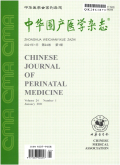母乳与乙型肝炎表面抗原的结合特性
Characterization of binding capability of human breast milk to hepatitis B surface antigen
摘要目的 探讨母乳能否与乙型肝炎表面抗原(hepatitis B surface antigen,HBsAg)结合以及结合特性. 方法 采集5例HBsAg和乙型肝炎表面抗体(hepatitis B surface antibody,抗HBs)均阴性产妇产后1~2个月的母乳.分别用母乳全乳、乳脂和乳蛋白与酵母表达的高纯度HBsAg孵育,以牛奶和羊奶作为对照,酶联免疫吸附(enzyme-linked immunosorbent assay,ELISA)法检测各成分与HBsAg的结合能力;化学发光微粒子免疫分析法检测各种乳汁对HBsAg与抗HBs结合的抑制率;温度敏感试验[包括煮沸1 min、巴氏消毒(65℃、30 min)及不加热处理]检测母乳中与HBsAg结合成分的热稳定性.采用单因素方差分析和SNK法进行统计学分析. 结果 本研究选择0.1 μg/ml的HBsAg为适当工作浓度进行试验.5例母乳均能明显与HBsAg结合(A450,1.306±0.300),而牛奶及羊奶与HBsAg的结合能力不明显(分别为2.157±0.150和2.232±0.093),差异有统计学意义(F=34.303,P<0.01).定量试验显示,母乳抑制HBsAg与抗HBs结合的抑制率为(74.26±17.26)%,高于PBS的(0.00±5.50)%,差异有统计学意义(F=57.806,P<0.01).乳脂、脱脂乳及全乳均能与HBsAg结合(A450,分别为0.877±0.486、0.513±0.069和0.376±0.146,F=44.475,P<0.01).经煮沸1 min或巴氏消毒处理后,母乳全乳与HBsAg的结合能力均无明显变化;而脱脂乳结合能力有所降低(F=16.598,P<0.01);母乳全乳和脱脂乳均能明显抑制HBsAg与抗-HBs的结合(F值分别为278.341和269.408,P值均<0.01). 结论 母乳具有与HBsAg结合的特性,其活性成分主要存在于乳蛋白,并具有热稳定性.母乳蛋白具有与HBV结合的能力.
更多相关知识
abstractsObjective To investigate whether human breast milk may bind to hepatitis B surface antigen (HBsAg) and its characteristics.Methods Breast milk samples from five women with negative HBsAg and hepatitis B surface antibody (anti-HBs) at one to two months post delivery were fractioned into cream and skimmed milk by centrifugation.The human breast milk and each fraction as well as cow and goat milk samples,served as controls,were separately incubated with highly purified yeast recombinant HBsAg,followed by determination of their binding capability to HBsAg by enzyme linked immunosorbent assay (ELISA) and the inhibition rate for binding of HBsAg to anti-HBs by quantitative chemiluminescence microparticle immunoassay.After boiled for 1 min or pasteurized in 65 ℃ for 30 min,the thermal stability of the active components of milk was detected.One-way ANOVA and SNK tests were performed for statistical analysis.Results The operative concentration of HBsAg was 0.1 μg/ml.Breast milk from all five women showed significantly better binding capability to HBsAg than cow or goat milk (1.306±0.300 vs 2.157±0.150 and 2.232±0.093,F=34.303,P<0.01).The quantitative experiments showed that the inhibition rate of human breast milk was higher than that of the control group [(74.26± 17.26)% vs (0.00±5.50)%,F=57.806,P<0.01].The binding ability to HBsAg of skimmed milk was comparable with that of whole milk,indicating milk protein(s) played critical roles in binding to HBsAg (0.877 ± 0.486 vs 0.513 ± 0.069 and 0.376 ± 0.146,F=44.475,P<0.01).After boiled for 1 min or Pasteurization,the binding ability to HBsAg of whole breast milk remained,but that of skimmed milk went down (F=16.598,P<0.01).Both whole breast milk and skimmed milk could inhibit the binding of HBsAg to anti-HBs (F=278.341 and 269.408,both P<0.01).Conclusions The inhibition of binding to HBsAg by human breast milk indicates that human milk may interact with HBsAg.The active components mainly exist in milk proteins and are thermal stable.
More相关知识
- 浏览116
- 被引12
- 下载224


相似文献
- 中文期刊
- 外文期刊
- 学位论文
- 会议论文



 换一批
换一批 换一批
换一批



